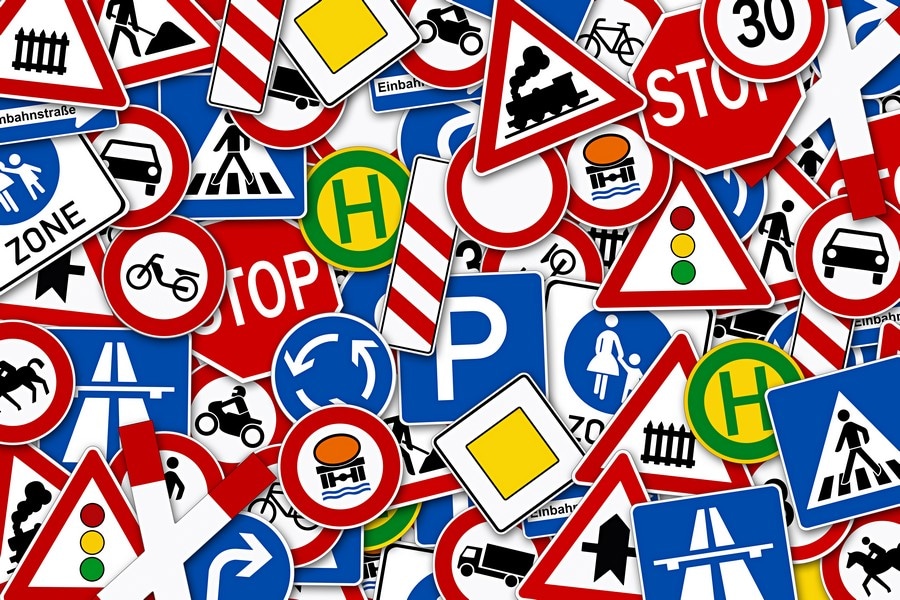
Definition of a Blind Spot
A blind spot is an area around a vehicle that cannot be seen by the driver either in the rear-view or side-view mirrors. This area is usually located directly behind the vehicle and to the sides of the vehicle. In the context of driving, a blind spot refers to the areas that are not visible to the driver when looking in the mirrors.
When driving, it is important to be aware of these blind spots as they can be dangerous. Blind spots can hide other vehicles, cyclists, and pedestrians, making it easy to miss them when changing lanes or turning. This can lead to accidents or collisions if proper precautions are not taken.
Blind spots are typically located on the rear left and right sides of the vehicle. In addition to these, a vehicle’s design can also create pillar blind spots, which are located around the glass on the windows. The most important of these is the A-pillar, which is the material on either side of the windscreen that arches up into the roof.
Understanding the definition of a blind spot is important for safe driving. By being aware of the areas that cannot be seen in the mirrors, drivers can take extra care when changing lanes or turning. This includes physically turning their heads to cheque these blind spots before making any manoeuvres. It is also important to regularly adjust the mirrors to minimise blind spots and maximise visibility.
For learner drivers, it is crucial to ask their instructors about the blind spots and how best to check them. This will help them develop good habits and avoid being caught off guard by blind spots when they start driving on their own. Overall, understanding the definition of a blind spot and being aware of its presence is essential for safe and responsible driving.
Understanding the Dangers of Blind Spots
Blind spots are areas around a vehicle that cannot be seen by the driver through the windows or in the rear-view and side-view mirrors. These blind spots can pose significant dangers on the road, especially for learner drivers who may not be as experienced in identifying and managing them.
Dangers Associated with Blind Spots
The main danger associated with blind spots is that they can hide other vehicles, cyclists, or pedestrians from the driver’s view. This lack of visibility can lead to collisions or accidents if the driver is not aware of the presence of these road users. Blind spots can also result in drivers making incorrect decisions, such as changing lanes without checking for other vehicles in the blind spot. This can lead to a sudden collision or the driver cutting off another vehicle, causing them to take evasive action.
How Blind Spots Lead to Accidents or Collisions
Blind spots can lead to accidents or collisions when the driver is not aware of their presence and fails to take the necessary precautions. For instance, when a driver is changing lanes and does not check their blind spot, they may not see another vehicle in the lane they are trying to enter. This can result in a collision if the other vehicle is travelling at a high speed and the driver merges without giving them enough space. Similarly, when a driver is reversing and does not check their blind spot, they may not see a pedestrian or cyclist behind them. This can lead to an accident if the pedestrian or cyclist is in the driver’s path and the driver reverses without noticing them.
Importance of Learner Drivers Being Aware of Blind Spot Dangers
It is crucial for learner drivers to be aware of the dangers associated with blind spots for several reasons. Firstly, as novice drivers, they may not have developed the same level of experience and instinct in detecting blind spots as more experienced drivers. Therefore, being aware of blind spot dangers can help them develop the necessary skills to identify and manage blind spots effectively.
Secondly, learner drivers are still in the process of acquiring the knowledge and skills needed to navigate various road situations safely. By understanding the dangers of blind spots, they can learn to be more cautious and proactive in checking their blind spots before making any manoeuvres, such as changing lanes or merging into traffic.
Lastly, being aware of blind spot dangers can help learner drivers develop a defensive driving mindset. They will understand the importance of constantly scanning their surroundings, using mirrors, and checking blind spots to ensure the safety of themselves and others on the road. This awareness can contribute to the overall improvement of their driving skills and reduce the likelihood of accidents or collisions caused by blind spots.
In conclusion, blind spots pose significant dangers on the road, as they can hide other vehicles, cyclists, or pedestrians from the driver’s view. This lack of visibility can lead to accidents or collisions if the driver is not aware of blind spot dangers and fails to take the necessary precautions. For learner drivers, understanding these dangers is crucial as it helps them develop the skills, caution, and defensive driving mindset needed to navigate blind spots safely and reduce the risk of accidents.
Identifying Blind Spots in a Vehicle
Learner drivers can identify blind spots in their vehicles by using a combination of techniques. Firstly, they should adjust their mirrors to ensure that they have a clear view of the road behind them. This can help to reduce the size of the blind spot. Learner drivers should also regularly cheque their blind spot by looking over their shoulder. This head cheque allows them to identify any vehicles or objects that may be in their blind spot and are not visible in the mirrors. Additionally, learner drivers can use the three-point turn technique when turning around in a tight space. This manoeuvre helps them to identify any vehicles or objects that may be in their blind spot.
The common signs or indicators of a blind spot include difficulty seeing vehicles or objects in the rear-view mirror. If a learner driver is having trouble seeing vehicles or objects in the rear-view mirror, it could be an indication that they have a blind spot. Another sign is difficulty seeing vehicles or objects when looking over the shoulder. If a driver is unable to see objects when performing a head cheque, it suggests the presence of a blind spot. Some vehicles are equipped with blind spot detection systems, which use sensors to detect objects in the blind spot and alert the driver. These systems can be another indicator of a blind spot.
Accurately identifying blind spots is important for several reasons. Firstly, it helps to ensure the safety of other road users. By being aware of any objects in their blind spot, drivers can take the necessary action to avoid a collision. Blind spots can hide pedestrians, cyclists, or other vehicles, so accurately identifying them is crucial for preventing accidents. Secondly, accurately identifying blind spots allows drivers to make informed decisions when changing lanes or making turns. By knowing where their blind spots are, drivers can take extra caution and make sure it is safe to proceed. Overall, accurately identifying blind spots is essential for maintaining road safety and preventing accidents.
Techniques for Checking Blind Spots
The recommended techniques for checking blind spots while driving are as follows:
- Use your mirrors: Regularly check your rearview and side mirrors to get a good view of the vehicles around you. This will help you identify any potential blind spots.
- Look over your shoulder: When changing lanes, it is important to turn your head and look over your shoulder to check for any vehicles in your blind spot. Mirrors may not always provide a complete view, so physically looking over your shoulder is crucial.
- Use your signals: Always use your turn signals when changing lanes to alert other drivers of your intentions. This will help them anticipate your movements and avoid any potential collisions.
- Be aware of your surroundings: Pay attention to the vehicles around you and be aware of any potential blind spots. This includes being mindful of vehicles merging into your lane or turning into side roads.
To effectively check blind spots, learners should follow these steps:
- Mirror-Signal-Manoeuvre Technique: This technique involves checking the interior and exterior mirrors to get an overall view of the road. After checking the mirrors, signal your intention to other road users. Then, look over your shoulder to check the blind spot. Finally, manoeuvre the vehicle when it is safe to do so.
- Shoulder check: The shoulder check is a quick and easy way to check blind spots. Before changing lanes or turning, look over your shoulder in the direction of the blind spot. Turn your head to get a better view. Additionally, check the interior and exterior mirrors to ensure you have an overall view of the road. Signal your intention to other road users and manoeuvre the vehicle when it is safe.
Regularly checking blind spots is necessary for several reasons:
- Safety: Checking blind spots helps ensure the safety of yourself and other road users. Blind spots can hide other vehicles, cyclists, and pedestrians, and failing to check them can lead to accidents or collisions.
- Compliance with driving regulations: Checking blind spots is a requirement for passing a driving test and is an essential skill for safe driving. Learner drivers need to demonstrate their ability to effectively check blind spots to obtain a driver’s licence.
- Avoiding collisions: Blind spots can hide vehicles that may be in close proximity to your vehicle. By regularly checking blind spots, you can avoid collisions and safely navigate through traffic.
In conclusion, regularly checking blind spots is crucial for the safety of all road users. Learner drivers can effectively check blind spots by using their mirrors, looking over their shoulder, using signals, and being aware of their surroundings. It is necessary to regularly check blind spots to ensure compliance with driving regulations, avoid collisions, and maintain a safe driving environment.
Best practices for Avoiding Blind Spots
The best practices for avoiding blind spots while driving include adjusting your mirrors, checking your blind spots, using your turn signals, and avoiding distractions. Learners can minimise the risk of encountering blind spots by practising and being aware of their surroundings. It is important to actively avoid blind spots in order to ensure the safety of yourself and other road users.
Adjusting Your Mirrors
One of the best practices for avoiding blind spots is to adjust your mirrors correctly. Make sure your mirrors are positioned in a way that allows you to see as much of the road as possible. This can help to minimise the size of your blind spots and increase your overall visibility.
Checking Your Blind Spots
Before changing lanes or making a turn, it is crucial to check your blind spots. Blind spots are areas around your vehicle that cannot be seen through the windows or in the mirrors. To check your blind spots, you should look over your shoulder to ensure there are no vehicles, cyclists, or pedestrians in those areas. This extra step can help you avoid potential collisions with objects that may be hidden from your view.
Using Your Turn Signals
Using your turn signals is another important practice for avoiding blind spots. When changing lanes or making a turn, always use your turn signals to indicate your intentions to other drivers. This allows them to anticipate your movements and adjust their driving accordingly. By using your turn signals, you can help prevent accidents that may occur due to other drivers being unaware of your intended actions.
Avoiding Distractions
Distractions can significantly reduce your awareness of your surroundings, including blind spots. It is important to avoid distractions such as using your phone, eating, or engaging in other activities that take your attention away from the road. By staying focused on driving, you can better identify and react to potential blind spots and avoid any potential hazards.
Practising and Being Aware
Learners can minimise the risk of encountering blind spots by practising their driving skills and being aware of their surroundings. practice driving in different conditions and environments to become more familiar with blind spots and how to effectively check them. Additionally, learners should always be aware of other vehicles on the road and their blind spots. This awareness can help them anticipate potential blind spot situations and take appropriate actions to avoid accidents.
Importance of Avoiding Blind Spots
It is important to actively avoid blind spots because they can pose a significant risk to the safety of yourself and other road users. Blind spots can hide other vehicles, cyclists, and pedestrians, making it difficult for you to see and react to potential hazards. By actively avoiding blind spots, you can minimise the chances of being involved in accidents and ensure the overall safety of everyone on the road.
Adjusting Mirrors to Reduce Blind Spots
To reduce blind spots, learners can adjust their mirrors by following these techniques:
- Adjust the rear-view mirror: Sit in the driver’s seat and adjust the rear-view mirror so that you can see the entire rear window. This will provide you with a clear view of the road behind you.
- Adjust the left side-view mirror: Position the left side-view mirror so that you can just see the side of your car. This will help you to have a wider field of view on the left side of your vehicle, reducing the blind spot on that side.
- Adjust the right side-view mirror: Similarly, adjust the right side-view mirror so that you can just see the side of your car. This will provide you with a wider field of view on the right side of your vehicle, minimising the blind spot on that side.
- cheque all three mirrors: After adjusting the mirrors, make sure to cheque all three mirrors to ensure that you can see as much of the road as possible without having to turn your head. This will help you to be aware of other drivers, cyclists, and pedestrians in your blind spots.
Proper mirror adjustment techniques are crucial for minimising blind spots and ensuring road safety. By positioning the mirrors correctly, learners can have a full view of the road without having to turn their heads, which allows them to be aware of their surroundings and potential hazards. Here are the key techniques:
- Angle the left mirror slightly outward: Adjust the left side-view mirror so that it is angled slightly outward. This will provide a wider view of the road behind you on the left side, reducing the blind spot on that side.
- Angle the right mirror slightly inward: Adjust the right side-view mirror so that it is angled slightly inward. This will provide a wider view of the road to the right of your car, minimising the blind spot on that side.
Mirror adjustment is crucial for minimising blind spots because it allows learners to have a full view of the road and be aware of other drivers, cyclists, and pedestrians. By adjusting the mirrors correctly, learners can reduce the areas where other vehicles may be hidden from their view, thus minimising the risk of accidents.
Properly adjusted mirrors help learners to see more of the road and be aware of potential hazards. By having a wider field of view, learners can anticipate the presence of other vehicles, cyclists, and pedestrians in their blind spots. This increased awareness allows them to make better decisions while driving, such as changing lanes or making turns, reducing the risk of collisions.
In addition, mirror adjustment helps learners to be more aware of their surroundings and make better decisions on the road. By having a clear view of the road behind and to the sides of their vehicle, learners can assess the traffic situation more accurately and react accordingly. This improves overall safety on the roads and reduces the likelihood of accidents.
Being Aware of Vehicle Size: Learner drivers should be aware of the size and shape of their vehicle and the blind spots it may create. Larger vehicles, such as trucks or buses, often have larger blind spots. Understanding the blind spots specific to their vehicle can help learners take extra precautions when driving.
Being Mindful of Other Road Users: Learner drivers should also be aware of the blind spots created by other vehicles, such as large trucks or buses. They should also be mindful of blind spots created by other road users, such as cyclists or pedestrians. Being aware of these blind spots can help learners anticipate potential hazards and take appropriate actions to avoid accidents.
When navigating traffic while being mindful of blind spots, learner drivers should be aware of the speed and direction of other vehicles. This can help them anticipate potential blind spot situations and adjust their driving accordingly. By maintaining a vigilant and proactive approach, learners can minimise the risks associated with blind spots and ensure the safety of themselves and other road users.
Having a proactive approach to managing blind spots is important because blind spots can hide other vehicles, cyclists, and pedestrians. Failing to effectively manage blind spots can lead to accidents and endanger the lives of both the learner driver and others on the road. By being proactive and employing strategies such as adjusting mirrors, checking blind spots, and being aware of other road users, learner drivers can significantly reduce the chances of blind spot-related accidents. It is crucial for learner drivers to prioritise safety and take the necessary steps to manage blind spots effectively.
Improving Blind Spot Awareness
How can learners improve their awareness of blind spots?
Learners can improve their awareness of blind spots by regularly checking their mirrors and blind spots before changing lanes, turning, or reversing. This practice helps them become more aware of their surroundings and identify any potential hazards. Additionally, learners should be aware of the size and shape of their vehicle and the blind spots that come with it. By understanding the importance of regularly checking their mirrors and blind spots, learners can develop a habit of being vigilant and attentive to their surroundings.
Why is it essential to continuously work on improving blind spot awareness?
It is essential to continuously work on improving blind spot awareness because it is a key part of safe driving. Blind spots can be difficult to detect and can lead to dangerous situations if not properly checked. By regularly checking the mirrors and blind spots, drivers can ensure that they are aware of their surroundings and can make informed decisions when changing lanes, turning, or reversing. Developing blind spot awareness helps drivers anticipate and react to potential hazards, reducing the risk of accidents. Continuous improvement in blind spot awareness is crucial for learner drivers to become safe and responsible drivers on the road.
What the Highway Code Says about Blind Spots
The Highway Code provides guidelines and rules for drivers and riders to be aware of blind spots and take necessary precautions when changing lanes or turning. It emphasises the importance of checking blind spots before setting off, changing lanes, turning, or when other vehicles are merging into your lane.
Rules and Guidelines:
- Always check your blind spots before setting off, changing lanes, turning, or when other vehicles are merging into your lane.
- When changing lanes, check your left-hand mirrors and blind spot before changing into the left lane, and check your right-hand mirrors and blind spot before moving into the right lane.
- Take extra care on busier roads where there is a higher likelihood of pedestrians, cyclists, or cars slipping into your blind spots.
- When overtaking a cyclist or motorcyclist, be sure to cheque your blind spots before turning or changing lanes.
- At junctions, cheque your A-pillars for any traffic coming from the left or right.
Importance for Learner Drivers:
It is crucial for learner drivers to adhere to the Highway Code’s advice on blind spots for several reasons. Firstly, being aware of blind spots and checking them before making any manoeuvres can help prevent accidents. Blind spots are areas around the vehicle that cannot be seen in the mirrors, and failing to check them can lead to collisions with other vehicles, cyclists, or pedestrians.
Secondly, signalling your intentions to other drivers is essential for maintaining road safety. By indicating your lane changes or turns, you provide valuable information to other road users, allowing them to anticipate your actions and adjust their driving accordingly. This helps to prevent confusion and potential accidents.
Furthermore, learner drivers are still developing their driving skills and may not be fully aware of the potential risks associated with blind spots. Adhering to the Highway Code’s guidelines on blind spot awareness can help them develop good habits from the start and ensure the safety of themselves and other road users.
In summary, the Highway Code emphasises the importance of being aware of blind spots and taking necessary precautions when changing lanes or turning. Learner drivers should adhere to these guidelines to prevent accidents, signal their intentions to other drivers, and develop good driving habits.
Expert Insights on Blind Spots and Driving
The experts at Smart Drive UK emphasise the importance of being aware of blind spots when driving. They point out that blind spots can be large enough to block another car, motorbike, cyclist, or pedestrian from view, and that they can be found on the rear left and right side of the average car. In addition, they note that vehicle design can create pillar blind spots, which are smaller but still important to consider.
Smart Drive UK recommends that learner drivers check their blind spots when moving left or right, such as when changing lanes. They also suggest that drivers take extra care on busier roads, where it is more likely that someone could slip into a blind spot. Additionally, they advise drivers to be aware of the A-pillar blind spot, which is the material on either side of the windscreen that arches up into the roof.
Considering the expertise of driving professionals is valuable for learner drivers, as they can provide valuable advice and tips on how to stay safe on the roads. Professional drivers have years of experience and can provide insight into potential hazards and how to avoid them. They can also provide advice on how to adjust mirrors and cheque blind spots to reduce the risk of accidents.
Key Takeaways about Blind Spots for Learner Drivers
- Blind spots are areas around a vehicle that cannot be seen by the driver, even when using mirrors.
- Blind spots can be reduced by adjusting the mirrors correctly and using the head check technique.
- Blind spots can be dangerous as they can hide other vehicles, cyclists, and pedestrians.
Contact Smart Drive UK for Driving Lessons
Learner drivers can easily get in touch with Smart Drive UK for driving lessons by visiting their website or calling their customer service line. The website provides detailed information about their services, including their instructors, packages, and pricing. This allows learners to gather all the necessary information before making a decision. Additionally, Smart Drive UK offers a free consultation to discuss individual needs and answer any questions learners may have.



